Flora of New York/Ericales
| ← Cornales |
Flora of New York — Ericales | → Gentianales | |||
| Table of contents |
Genus index |
Protected species index | Invasive species index | ||
Ericales introduction
[edit | edit source]The order Ericales comprises 22 families (Actinidiaceae, Balsaminaceae, Clethraceae, Cyrillaceae, Diapensiaceae, Ebenaceae, Ericaceae, Fouquieriaceae, Lecythidaceae, Marcgraviaceae, Mitrastemonaceae, Pentaphylacaceae, Polemoniaceae, Primulaceae, Roridulaceae, Sapotaceae, Sarraceniaceae, Sladeniaceae, Styracaceae, Symplocaceae, Tetrameristaceae, Theaceae):[1][2][3]
|
Family Balsaminaceae
[edit | edit source]The Balsaminaceae (balsam family) contains the two genera: Impatiens with about 1000 species and Hydrocera with a single species. Of these, four Impatiens species have been reported growing wild in New York.[1][2][3]
|
Impatiens
[edit | edit source]| Genus Impatiens | Touch-me-not | N.Y. Status | Images | Distribution | NY NPT |
Meerb. 1775. Impatiens capensis Meerb.
1788. Impatiens biflora Walter
1813. Impatiens maculata Muhl. (not validly publ.)
1818. Impatiens fulva Nutt.
1849. Balsamina fulva (Nutt.) Ser.
1910. Impatiens nortonii Rydb.
1916. Chrysaea biflora (Walter) Nieuwl. & Lunell
1967. Impatiens noli-tangere ssp. biflora (Walter) Hultén |
Spotted jewelweed, Orange touch-me-not, Spotted touch-me-not, Spotted snapweed Impatiente du Cap, Chou sauvage, Impatiente biflore |
Native, CoC: 3, Secure, S5 FACW Annual, Herb-forb |

|
NYFA: 5 |
USDA-NN Go Botany VASCAN ARS-GRIN ITIS Tropicos Images Wikispecies |
Nutt. 1803. Impatiens noli-tangere Michx. (sensu auct.)
1813. Impatiens aurea Muhl.
1818. Impatiens pallida Nutt.
1904. Impatiens pallida var. alba Clute
1916. Chrysaea aurea (Muhl.) Nieuwl. & Lunell |
Pale jewel-weed, Pale snapweed, Pale touch-me-not, Yellow touch-me-not Impatiente pâle |
Native, CoC: 3, Likely secure, S4, G5 FACW Annual, Herb-forb |

|
NYFA: 4 |
USDA-NN Go Botany VASCAN ARS-GRIN ITIS Tropicos Images Wikispecies |
Royle 1835. Impatiens glandulifera Royle
1840. Impatiens glanduligera Lindl.
1842. Impatiens roylei Walp. (nom. superfl.)
1849. Balsamina roylei (Walp.) Ser.
2021. Impatiens sulcata var. glandulifera (Royle) R.Kr.Singh & D.Borah |
Ornamental jewelweed, Policeman's helmet, Himalayan balsam, Himalayan touch-me-not Balsamie de l'Himmalaya, Impatiente glanduleuse, Balsamine géante |
Introduced from India, Nepal, Pakistan, Moderately invasive, NYIS: 67%[1], SNA, GNR Annual, Herb-forb |

|
Columbia, Essex, Jefferson, Lewis, Madison, Schuyler, Sullivan NYFA: X |
USDA-XX Go Botany VASCAN ARS-GRIN ITIS Tropicos Images Wikispecies |
L. 1753. Impatiens balsamina L.
1790. Balsamina foemina Gaertn.
1922. Impatiens giorgii De Wild.
1962. Impatiens eriocarpa Launert |
Garden balsam, Garden touch-me-not, Spotted snapweed, Rose balsam |
Introduced from India, Myanmar, SNA, GNR UPL Annual, Herb-forb |

|
Erie, Kings, Nassau, Suffolk NYFA: X |
USDA-XX ARS-GRIN ITIS Tropicos Images Wikispecies |
Hook. f. 1903. Impatiens balfourii Hook. f.
1928. Impatiens mathildae Chiov. |
Balfour’s touch-me-not ⓘ
Kashmir Balsam ⓘ
Poor Man's Orchid ⓘ Impatience de Balfour ⓘ
Impatiente des jardins ⓘ
|
Introduced, Potentially invasive |

|
NYFA: Xu NYFA: New York (2015) 2 counties |
POWO Images Wikispecies |
| |||||
Family Polemoniaceae
[edit | edit source]The Polemoniaceae (phlox family).[1]
Subamily Polemonioideae
[edit | edit source]Tribe Polemonieae
[edit | edit source]Polemonium
[edit | edit source]
|
| Genus Polemonium | Jacob's ladder | N.Y. Status | Images | Distribution | NY NPT |
L. var. reptans |
Common Jacob's-ladder, Creeping Jacob's-ladder, Spreading Jacob's-ladder, Greek valerian, Charity Polémoine rampante, Valériane grecque |
Native, CoC: 7, Likely secure FAC-FACU Perennial, Herb-forb, Subshrub |

|
NYFA: 4 |
USDA-NN Go Botany VASCAN ITIS BONAP Images Wikispecies |
Britton |
Vanbrunt's Jacob's ladder, Vanbrunt's polemonium, Bog Jacob's ladder Polémoine de Van-Brunt |
Native, CoC: 7, Rare FACW Perennial, Herb-forb |

|
NYFA: 3 |
USDA-NN Go Botany VASCAN ARS-GRIN ITIS Tropicos BONAP Images Wikispecies |
| Genus Polemonium (unlisted taxa) | Jacob's ladder | N.Y. Status | Images | Distribution | NY NPT |
L. |
Blue Jacob's-ladder, Charity, Greek-valerian Polémoine bleue, Valériane grecque |
Introduced from Eurasia, Cultivated FACW Perennial, Herb-forb |

|
NYFA: 0 NYFA: Not listed Jefferson County 2017 |
USDA- Go Botany VASCAN ARS-GRIN ITIS BONAP Images Wikispecies |
|
| |||||
Tribe Phlocideae
[edit | edit source]Phlox
[edit | edit source]The sectional classification of the genus Phlox used here (Wherry 1955, Grant 1959)[1] is:
Of these sections, only the herbaceous North American sections Phlox and Divaricatae contain native or naturalized species reported in New York. |
Phlox sect. Divaricatae
[edit | edit source] |
| Genus Phlox sect. Divaricatae | Phlox | N.Y. Status | Images | Distribution | NY NPT |
L. ssp. divaricata |
Timber phlox ⓘ
Wild blue phlox ⓘ
Woodland phlox
|
Native, CoC: 8, Likely secure |

|
NYFA: 4 |
USDA-NN Go Botany Images Wikispecies |
L. ssp. pilosa1753. Phlox pilosa L.
1911. Phlox argillacea Clute & Ferriss
1931. Phlox pilosa var. amplexicaulis (Raf.) Wherry
1931. Phlox pilosa var. virens (Michx.) Wherry |
Downy phlox | Native, CoC: 10, Endangered, Impersistent, SH FACU Perennial, Herb-forb |

|
Niagara (1838) NYFA: 1z |
USDA-NN ARS-GRIN ITIS NatureServe BONAP Images Wikispecies |
|
| |||||
Phlox sect. Phlox
[edit | edit source]| Genus Phlox sect. Phlox | Phlox | N.Y. Status | Images | Distribution | NY NPT |
L. ssp. subulata1753. Phlox subulata L.
1823. Phlox aristata Lodd.
1891. Armeria subulata (L.) Kuntze |
Moss phlox ⓘ
Creeping phlox ⓘ
Moss pink ⓘ
Ground pink ⓘ
Mountain phlox ⓘ
|
Native, CoC: 7, Likely secure, S4 Perennial, Herb-forb |

|
NYFA: 4 |
USDA-NN ARS-GRIN Tropicos Images Wikispecies |
L. ssp. maculata1753. Phlox maculata L. |
Wild sweet-william ⓘ
Wild sweetwilliam ⓘ
Meadow phlox ⓘ
Spotted phlox ⓘ
|
Native, CoC: 7, Endangered, S2, G5 FACW Perennial, Herb-forb |

|
NYFA: 1 |
USDA-NX ARS-GRIN ITIS Tropicos NatureServe BONAP Images Wikispecies |
L. 1753. Phlox paniculata L.
1813. Phlox acuminata Pursh
1813. Phlox decussata Lyon ex Pursh |
Fall phlox | Introduced, US South native, SNA, G5 FACU Perennial, Herb-forb, Sun |

|
NYFA: X |
USDA-NX Go Botany ARS-GRIN NatureServe BONAP LBJ Images Wikispecies |
Sims 1892. Phlox stolonifera Sims |
Creeping phlox ⓘ
Cherokee phlox ⓘ
|
Introduced, US South native, Not naturalized, SNA, G4-5 Perennial, Herb-forb |

|
Fulton, Rensselaer (1947) NYFA: X |
USDA- Go Botany ARS-GRIN NatureServe BONAP Images Wikispecies |
|
| |||||
Tribe Gilieae
[edit | edit source]Collomia
[edit | edit source]| Genus Collomia | Trumpet | N.Y. Status | Images | Distribution | NY NPT |
(Cav.) Nutt. 1800. Phlox linearis Cav.
1818. Collomia linearis (Cav.) Nutt.
1882. Gilia linearis (Nutt.) A. Gray
1891. Navarretia linearis (Nutt.) Kuntze |
Tiny trumpet
Narrow-leaved collomia ⓘ
Narrow leaved collomia
Narrow-leaved mountain-trumpet ⓘ
Slenderleaf collomia
|
Introduced from western N. America, N. America native, Impersistent, Not naturalized, SNA, G5 FACU-UPL Annual, Herb-forb |

|
Cattaraugus (1899) NYFA: Xm |
USDA-NN ARS-GRIN Tropicos BONAP Images Wikispecies |
|
| |||||
Gilia
[edit | edit source] Although excluded by the New York Flora Atlas, "reaserch-grade" iNaturalist observations of Gilia capitata (bluehead gilia) were made in 2020 in Nassau County[1] and in 2021 in Ulster County.[2] |
| Genus Gilia | Gilia | N.Y. Status | Images | Distribution | NY NPT |
Benth. ssp. achilleifolia 1833. Gilia achilleifolia Benth. |
California gilia, Blue gilia |
Introduced from California, N. America native, Impersistent, SNA Annual, Herb-forb |

|
Kings (1880) NYFA: Xm |
USDA-X0 Go Botany ITIS Tropicos BONAP Images Wikispecies |
| Genus Gilia (excluded taxa) | Gilia | N.Y. Status | Images | Distribution | NY NPT |
Sims 1826. Gilia capitata Sims
1891. Navarretia capitata (Sims) Kuntze |
Bluehead gilia ⓘ
Gillyflower ⓘ
Field gilia ⓘ
|
Introduced, N. America native, Excluded |

|
Nassau (2020), Ulster (2021) NYFA-Excluded |
USDA-NX Tropicos BONAP Images Wikispecies |
|
| |||||
Tribe Loeselieae
[edit | edit source]Ipomopsis
[edit | edit source] |
| Genus Ipomopsis (excluded taxa) | Ipomopsis | N.Y. Status | Images | Distribution | NY NPT |
(L.) Wherry 1753. Polemonium rubrum L.
1891. Navarretia rubra (L.) Kuntze
1895. Gilia rubra (L.) Heller
1936. Ipomopsis rubra (L.) Wherry |
Red standing-cypress
Standing-cypress
|
N. America native southern U.S., N.Y. excluded |

|
excluded NYFA-Excluded |
USDA-NX ARS-GRIN Tropicos Images Wikispecies |
|
| |||||
Family Ebenaceae
[edit | edit source]The Ebenaceae (ebony family) is primarily a tropical and warmer-temperate family of trees and shrubs. Its only species reported outside of cultivation in New York is the American persimmon tree, which consists mainly of escapes from cultivation. It is believed that the only native persimmon trees in the state are on Staten Island (Richmond County) and Long Island (Nassau and Suffolk Counties).[1][2]
|
Subfamily Ebenoideae
[edit | edit source]Diospyros
[edit | edit source] In New York State, the only known native persimmon populations are in New York City and Long Island. Most of the naturalized trees in the state are assumed to be garden escapes. [1] The genus name Diospyros was derived from the Greek dios (divine) and pyros (wheat or grain) in reference to the tree's "divine fruit." Persimmons are dioecious, requiring the presence of both male and female trees to produce fruit. |
| Genus Diospyros | Persimmon | N.Y. Status | Images | Distribution | NY NPT |
L. 1753. Diospyros virginiana L. in Sp. Pl.:1057 |
Persimmon, Common persimmon, American persimmon Plaqueminier d'Amérique |
Native, CoC: 8, Threatened, S2, G5, NYNHP: S2[1] FAC Perennial, Tree, Heliophily: 6 Part shade, 2n = 60, 90 |

|
NYFA: 8 counties iNat: 13 counties |
USDA-N0 FSUS Go Botany ARS-GRIN FNAFNA Tropicos NatureServe BONAP LBJ MBG Images Wikispecies |
Family Primulaceae
[edit | edit source]| The Primulaceae Batsch ex Borkh. (primrose family).[1] Note that this family does not include evening primroses (Oenothera), which are in the Onagraceae (evening primrose or willowherb family) in the order Myrtales.
The classification used here for Primulaceae is based primariliy on P. F. Stevens (2001-2015). Angiosperm Phylogeny Website. Version 14, April 2015.
|
Subfamily Theophrastoideae
[edit | edit source]The Theophrastoideae (brookweeds &&) ...
Tribe Samoleae
[edit | edit source]The Samoleae (brookweeds) ...
Samolus
[edit | edit source] |
| Genus Samolus | Brookweed | N.Y. Status | Images | Distribution | NY NPT |
L. 1753. Samolus valerandi L.
1818-1. S. parviflorus Raf.
1818-2. S. floribundus Kunth
1825. S. americanus Spreng.
1971. S. valerandi ssp. parviflorus Hultén |
Water pimpernel
Brookweed
Seaside brookweed ⓘ
|
Native, Likely secure |

|
NYFA: 4 |
USDA-NN Go Botany VASCAN ARS-GRIN ITIS FNA Tropicos BONAP Images Wikispecies |
|
| |||||
Subfamily Primuloideae
[edit | edit source]Primula
[edit | edit source]Primula subg. Aleuritia
[edit | edit source] The only non-native member of subg. Aleuritia reported to have naturalized in New York is Japanese primrose, which has been found in Onondaga and Otsego counties. |
| Genus Primula subg. Aleuritia sect. Aleuritia | Primrose | N.Y. Status | Images | Distribution | NY NPT |
Michx. 1803. Primula mistassinica Michx.
1888. Primula farinosa var. mistassinica (Michx.) Pax
1894. Primula sibirica var. mistassinica (Michx.) Kurtz
1905. Primula farinosa ssp. mistassinica (Michx.) Pax
1928. Primula intercedens Fernald
1928. Primula mistassinica var. intercedens Fernald
1966. Primula mistassinica var. intercedens B.Boivin |
Lake Mistassini primrose ⓘ
Bird's-eye primrose ⓘ
Mistassini primrose ⓘ
Dwarf Canadian primrose ⓘ Primevère du lac Mistassini ⓘ
Primevère de Mistassini ⓘ
|
Native, CoC: 10, Threatened, NYNHP: 2[1] FACW Perennial, Herb-forb, Shade |

|
NYFA: 2 |
USDA-NN Go Botany VASCAN ITIS FNA Tropicos BONAP LBJ Images Wikispecies |
| Genus Primula subg. Aleuritia sect. Proliferae | Primrose | N.Y. Status | Images | Distribution | NY NPT |
A.Gray 1858. Primula japonica A.Gray
1980. Aleuritia japonica (A.Gray) Soják |
Japanese primrose Primevère du Japon |
Introduced from Japan, Highly invasive, Naturalized |

|
NYFA: X NYFA: 2 counties GBIF 6 counties |
USDA-X0 ARS-GRIN Tropicos Images Wikispecies |
Primula subg. Primula
[edit | edit source] |
| Genus Primula subg. Primula sect. Primula | Primrose | N.Y. Status | Images | Distribution | NY NPT |
L. 1753. Primula veris L.
1765. Primula officinalis (L.) Hill |
Cowslip, Cowslip primrose Primevère officinale |
Introduced from Europe, temperate w. Asia, Naturalized |

|
NYFA: X |
USDA-XW VASCAN ARS-GRIN Images Wikispecies |
| Genus Primula subg. Primula sect. Primula (excluded taxa) | Primrose | N.Y. Status | Images | Distribution | NY NPT |
Mill. Primula veris × Primula vulgaris |
Elatior hybrid primrose, False oxlip |
Introduced, N.Y. excluded, Only cultivated |

|
NYFA-Excluded |
USDA-XX VASCAN ARS-GRIN Images Wikispecies |
|
| |||||
Primula subg. Auriculastrum
[edit | edit source] sooting star The New York Natural Heritage Program Rare Plant Status List - Active Inventory List listed
|
| Genus Primula subg. Auriculastrum sect. Dodecatheon | Shooting-star | N.Y. Status | Images | Distribution | NY NPT |
(L.) A.R.Mast & Reveal 1753. Dodecatheon meadia L.
1768. Meadia dodecatheon Mill.
1818. Dodecatheon angustifolium Raf.
1903. Dodecatheon hugeri Small
1903. Dodecatheon brachycarpum Small
2007. Primula meadia A.R.Mast & Reveal In: Brittonia 59(1):81 |
Eastern shooting star, Shooting star, Pride of Ohio, American cowslip, Mead's shootingstar Gyroselle de Virginie |
Native, CoC: 10, Extirpated, SX, G5 FACU Perennial, Herb-forb, Heliophily: 5 |
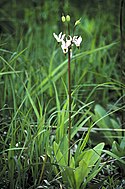
|
NYFA: Steuben iNat: 7 counties GBIF: present in NY |
USDA-NN POWO FSUS Go Botany VASCAN ARS-GRIN ITIS FNA Tropicos NatureServe BONAP Images Wikispecies |
|
| |||||
Hottonia
[edit | edit source]| Genus Hottonia | Hottonia | N.Y. Status | Images | Distribution | NY NPT |
Elliott 1817 |
American featherfoil, Featherfoil, Hottonie enflée |
Native, Threatened |

|
NYFA: 2 |
USDA-NN Go Botany Images Wikispecies |
|
| |||||
Androsace
[edit | edit source]| Genus Androsace | Rock jasmine | N.Y. Status | Images | Distribution | NY NPT |
L. |
Androsace, Greater rock-jasmine, Pussy-toes |
Introduced | 
|
NYFA: X |
USDA-X0 Images Wikispecies |
|
| |||||
Subfamily Myrsinoideae
[edit | edit source]| The Myrsinoideae subfamily has previously been grouped into its own family (Myrsinaceae). It contains about 35 genera worldwide, but of those, only Lysimachia is known to be native or naturlized in New York. The genera Anagallis and Trientalis are now treated as part of Lysimachia.[1]
|
Lysimachia
[edit | edit source]| The grouping used here for genus Lysimachia is based on Anderberg (2007).[1]
|
Lysimachia subg. Trientalis
[edit | edit source]
|
| Genus Lysimachia subg. Trientalis | Starflower | N.Y. Status | Images | Distribution | NY NPT |
(Raf.) U.Manns & Anderb. 1803. Trientalis europaea Michx non L. 1753
1805. Trientalis europaea var. americana Pers.
1808. Trientalis borealis Raf.
1813. Trientalis americana Pursh
1872. Lysimachia trientalis var. americana (Pursh) Klatt
1924. Trientalis borealis var. tenuifolia House
2009. Lysimachia borealis (Raf.) U.Manns & Anderb. |
Northern starflower | Native, CoC: 6, Secure, S5 G5 FAC |

|
NYFA: 49 counties iNat |
USDA-NN POWO Go Botany Images Wikispecies |
|
| |||||
Lysimachia subg. Lysimachia group A
[edit | edit source] at Alley Park in Queens photographed by Zihao Wang
The New York species of group A are in sect. Seleucia. |
| Genus Lysimachia subg. Lysimachia sect. Seleucia | Yellow-loosestrife | N.Y. Status | Images | Distribution | NY NPT |
L. 1753. Lysimachia ciliata L.
1843. Steironema ciliatum (L.) Baudo
1891. Nummularia ciliata (L.) Kuntze |
Fringed loosestrife, Fringed yellow loosestrife, Ciliate loosestrife Lysimaque ciliée, Lysimaque fimbriée, Stéironéma cilié |
Native, CoC: 4, Secure |

|
NYFA: 5 |
USDA-N Go Botany VASCAN ARS-GRIN Tropicos Images Wikispecies |
Michx. 1788. Lysimachia ciliata Walter non L. (nom. illeg)
1803. Lysimachia hybrida Michx.
1860. Lysimachia ciliata var. hybrida (Michx.) Chapm.
1876. Lysimachia lanceolata var. hybrida (Michx.) A.Gray
1877. Steironema lanceolatum (Walter) A.Gray (misapplied)
1877. Steironema lanceolatum var. hybridum (Michx.) A.Gray
1901. Steironema laevigatum Howell
1903. Steironema hybridum (Michx.) Raf. ex Small
1913. Steironema validulum Greene ex Wooton & Standl.
1939. Lysimachia ciliata var. validula Kearney & Peebles |
Lowland loosestrife ⓘ
Lance-leaved loosestrife
Lowland yellow loosestrife
Mississippi loosestrife
Swamp candles Lysimaque hybride
|
Native, CoC: 10, Endangered, S1, G5 OBL Perennial, Herb-forb |

|
NYFA: 1 NYFA: 11 counties iNat 2 counties |
USDA-NN POWO Go Botany ITIS FNA Images Wikispecies |
Sims 1803. Lysimachia quadriflora Sims
1813. Lysimachia longifolia Pursh
1892. Steironema quadriflorum (Sims) C.L.Hitchc.
1913. Nummularia quadriflora (Sims) Farw. |
Linear-leaved loosestrife, Linear-leaf loosestrife, Four-flowered loosestrife, Fourflower yellow loosestrife, Linear-leaf loosestrife |
Native, CoC: 10, Endangered, S1, G5? OBL-FACW Perennial, Herb-forb |

|
NYFA: 1 NYFA: Erie, Niagara iNat No observations |
USDA-NN POWO ITIS Images Wikispecies |
|
| |||||
Lysimachia subg. Lysimachia group B
[edit | edit source]| Genus Lysimachia subg. Lysimachia sect. Nummularia | Yellow-loosestrife | N.Y. Status | Images | Distribution | NY NPT |
L. 1753. Lysimachia nummularia L. |
Moneywort
Creeping Jenny
Creeping loosestrife
Creeping yellow loosestrife Lysimaque nummulaire ⓘ
Herbe-aux-écus ⓘ
Monnayère ⓘ
|
Introduced from temperate Eurasia, Moderately invasive, NYIS: 64%[1] Perennial, Herb-forb |

|
NYFA: X |
USDA-XX Go Botany VASCAN ARS-GRIN Images Wikispecies |
L. 1753. Lysimachia punctata L. L. punctatavar. verticillata Klatt |
Spotted loosestrife, Large yellow loosestrife |
Introduced from temperate Eurasia, Moderately invasive, NYIS: 57%[2] |

|
NYFA: X |
USDA-XX Go Botany ITIS Images Wikispecies |
Lysimachia subg. Lysimachia group C
[edit | edit source]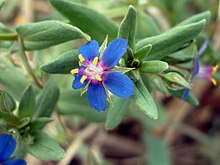
|
| Genus Lysimachia subg. Lysimachia | Pimpernel | N.Y. Status | Images | Distribution | NY /NPT |
(L.) U.Manns & Anderb. 1753. Anagallis arvensis L.
1759. Anagallis caerulea L.
1764. Anagallis arvensis var. caerulea (L.) Gouan
1927. Anagallis arvensis f. caerulea (L.) Lüdi
2009. Lysimachia arvensis (L.) U.Manns & Anderb. |
Scarlet pimpernel, Poor-man's weatherglass, Shepherd's clock, Scarlet yellow-loosestrife, Common pimpernel Mouron rouge, Mouron des champs |
Introduced from Eurasia, northern Africa, Potentially invasive, Invasive.org: [1], USGS: L48 established FACU-UPL Annual, Herb-forb |

|
NYFA: X GBIF |
USDA-XX Go Botany VASCAN ARS-GRIN Tropicos BONAP Images Wikispecies |
|
| |||||
Lysimachia subg. Lysimachia group E
[edit | edit source] |
| Genus Lysimachia subg. Lysimachia sect. Lysimachia | Yellow-loosestrife | N.Y. Status | Images | Distribution | NY NPT |
(L.) Britton, Sterns & Poggenb. 1753. Viscum terrestre L.
1788. Lysimachia vulgaris Walter (sensu auct)
1789. Lysimachia stricta Aiton
1789. Lysimachia bulbifera Curtis
1792. Lysimachia racemosa Lam.
1836. Lysimachia michauxii F.Dietr.
1888. Lysimachia terrestris (L.) Britton, Sterns & Poggenb.
1922. Lysimachia terrestris var. ovata (E.L.Rand & Redfield) Fernald |
Swamp candles, Swamp loosestrife, Swamp yellow loosestrife, Bog loosestrife, Bulblet loosestrife, Earth loosestrife, Lake loosestrife Lysimaque terrestre |
Native, Secure |

|
NYFA: 5 |
USDA-NN POWO Go Botany VASCAN ARS-GRIN FNA Tropicos Images Wikispecies |
L. 1753. Lysimachia quadrifolia L.
1777. Anagallis flava Houtt.
1788. Lysimachia punctata Walter
1803. Lysimachia hirsuta Michx.
1894. Lysimachia quadrifolia var. variegata Peck
1924. Lysimachia quadrifolia f. variegata (Peck) House |
Whorled loosestrife | Native, Secure |

|
NYFA: 5 |
USDA-NN Go Botany VASCAN Images Wikispecies |
L. (1753) Naumburgia thyrsiflora (L.) Duby |
Tufted loosestrife, Tufted yellow loosestrife, Water loosestrife, Swamp loosestrife, Lysimaque thyrsiflore |
Native, Likely secure |

|
NYFA: 4 |
USDA-NN Go Botany ARS-GRIN ITIS FNA Images Wikispecies |
Fernald Lysimachia terrestris × Lysimachia thyrsiflora |
Hybrid of Swamp loosestrife & Tufted loosestrife |
Native, Threatened |

|
NYFA: 2? |
Images Wikispecies |
(A. Gray) Fernald (pro sp.) Lysimachia quadrifolia × Lysimachia terrestris |
Hybrid of Whorled loosestrife & Swamp loosestrife |
Native, Vulnerable |

|
NYFA: 3? |
Images Wikispecies |
L. 1753. Lysimachia vulgaris L. |
Garden loosestrife, Garden yellow loosestrife Lysimaque commune |
Introduced, Highly invasive, NYIS: 73%[1], Prohibited[2] |

|
NYFA: X |
USDA-XX Go Botany FNA Tropicos Images Wikispecies |
| |||||
Lysimachia subg. Palladia + Lysimachiopsis
[edit | edit source] |
| Genus Lysimachia subg. Palladia + Lysimachiopsis | Loosestrife | N.Y. Status | Images | Distribution | NY NPT |
Duby 1844. Lysimachia clethroides Duby |
Goose-neck loosestrife ⓘ
Gooseneck loosestrife ⓘ
Gooseneck yellow loosestrife ⓘ Lysimaque faux-clèthre ⓘ
|
Introduced from temperate Asia, Potentially invasive, NYIS: not assessed[1] |

|
NYFA: Xm NYFA: 6 counties iNat GBIF 9+ counties |
USDA-XX VASCAN Images Wikispecies |
Family Symplocaceae
[edit | edit source]The Symplocaceae (sweetleaf family).[1]
Symplocos
[edit | edit source]
|
| Genus Symplocos | Sweetleaf | N.Y. Status | Images | Distribution | NY NPT |
(L.) L'Hér. 1767. Hopea tinctoria L.
1791. Symplocos tinctoria (L.) L'Hér.
1879. Protohopea tinctoria (L.) Miers
1891. Eugeniodes tinctorium (L.) Kuntze |
Sweetleaf ⓘ
Sweet-leaf
Common sweetleaf
Horsesugar ⓘ
Horse-sugar
|
Introduced, US South native |

|
NYFA: X NYFA: Suffolk iNat Cultivated NYC |
USDA-N0 Tropicos BONAP Images Wikispecies |
(Thunb.) Miq. 1784. Prunus paniculata Thunb.
1867. Symplocos paniculata (Thunb.) Miq. |
Sapphire berry
Sapphire-berry ⓘ
Asiatic sweetleaf
|
Introduced, Highly invasive, NYIS Tier: 2, USGS: L48 established |

|
NYFA: X NYFA: Nassau county iNat GBIF 4 counties |
USDA-X0 BONAP Images Wikispecies |
|
| |||||
Family Styracaceae
[edit | edit source]The Styracaceae (snowbell family) [1] contains snowbells and silverbell trees.
|
Halesia
[edit | edit source] |
| Genus Halesia | Silverbell | N.Y. Status | Images | Distribution | NY NPT |
L. 1759. Halesia carolina L. 1761. Halesia tetraptera J.Ellis 1803. Halesia parviflora Michx. 1914. Halesia carolinavar. monticola Rehder 1921. Halesia monticola (Rehder) Sarg. |
Silver bells, Possomwood, Carolina silverbell |
Introduced, US South native Perennial, Tree |

|
NYFA: X |
USDA-N0 Go Botany ARS-GRIN FNA NatureServe BONAP Images Wikispecies |
|
| |||||
Styrax
[edit | edit source]| Genus Styrax | Snowbell | N.Y. Status | Images | Distribution | NY NPT |
Lam. 1783. Styrax americanus Lam. 1803. Styrax pulverulentus Michx. 1917. Styrax americanus var. pulverulentus Rehder |
American snowbell, Mock orange |
Introduced, US South native, Cultivated |

|
NYFA: 0 |
USDA-N0 ARS-GRIN Tropicos NatureServe BONAP Images Wikispecies |
Sieb. & Zucc. |
Japanese snowbell, Japanese storax |
Introduced | 
|
NYFA: X NYFA: 2 counties GBIF 6 counties |
USDA-X0 ITIS FNA Images Wikispecies |
|
| |||||
Family Diapensiaceae
[edit | edit source]The Diapensiaceae (diapensia family).[1]
Diapensia
[edit | edit source]| Genus Diapensia | Diapensia | N.Y. Status | Images | Distribution | NY NPT |
L. ssp. lapponica |
Lapland diapensia, Pincushion plant |
Native, Threatened |

|
NYFA: 2 |
USDA- Images Wikispecies |
| |||||
Galax
[edit | edit source]| Genus Galax | Galax | N.Y. Status | Images | Distribution | NY NPT |
(Poir.) Brummitt auct. Galax aphylla non L. |
Beetleweed | Introduced, US South native, Not naturalized, Nassau, Suffolk Counties |

|
NYFA: X |
USDA-N0 Go Botany ITIS FNA LBJ Images Wikispecies |
|
| |||||
Pyxidanthera
[edit | edit source]| Genus Pyxidanthera | Pyxie moss | N.Y. Status | Images | Distribution | NY NPT |
| Common pyxiemoss, Flowering moss, Flowering pixiemoss, Big pyxie, Pyxies |
Native, CoC: 6, Endangered, Suffolk County only Perennial, Herb-subshrub |

|
NYFA: 1 |
USDA-N0 ITIS FNA Images Wikispecies | |
|
| |||||
Family Sarraceniaceae
[edit | edit source]The Sarraceniaceae (pitcher-plant family) are carnivorous plants, consisting of three New-World genera. The largest genus, Heliamphora, is endemic to South America, and the monospecific Darlingtonia is native to the West Coast of the U.S. The third genus, Sarracenia, with about eight species, is native to eastern North America.[1]
|
Sarracenia
[edit | edit source] purple pitcher-plant |
| Genus Sarracenia | Pitcher plant | N.Y. Status | Images | Distribution | NY NPT |
L. ssp. purpurea 1753. Sarracenia purpurea L. 1827. S. purpureavar. terrae-novae 1933. S. purpureassp. gibbosa 1933. S. purpureavar. stolonifera 1951. S. purpureavar. ripicola |
Purple pitcher-plant, Northern pitcher-plant, Side-saddle plant, Common pitcherplant, Huntsman's-cup, Huntsman's horn, Decumbent pitcher plant, Frog's-britches Sarracénie pourpre |
Native, CoC: 9, Vulnerable OBL Perennial, Herb-forb, Sun |

|
NYFA: 3-4 |
USDA-NN Go Botany VASCAN ARS-GRIN ITIS FNA BONAP LBJ Images Wikispecies |
|
| |||||
Family Actinidiaceae
[edit | edit source]The Actinidiaceae (Chinese gooseberry family) has only two species that have been found outside of cultivation in New York. Only one of these are considered to be naturalized.[1]
|
Actinidia
[edit | edit source] taravine or hardy kiwi |
| Genus Actinidia | Kiwifruit | N.Y. Status | Images | Distribution | NY NPT |
(Siebold & Zucc.) Planch. ex Miq. 1867. Actinidia arguta (Siebold & Zucc.) Planch. ex Miq. |
Hardy kiwi ⓘ
Baby kiwi ⓘ
Tara vine ⓘ
Taravine ⓘ
|
Introduced from temperate Asia, Highly invasive, NYIS Tier: 2, iMapInvasives, Invasive.org: [2], Naturalized |

|
NYFA: Xn NYFA: Westchester (2013) 2 counties |
USDA-X0 ARS-GRIN Images Wikispecies |
(Siebold & Zucc.) Planch. ex Maxim. 1843. Trochostigma polygamum Siebold & Zucc. 1859. Actinidia polygama (Siebold & Zucc.) Planch. ex Maxim. |
Silver vine, Cat powder, Matatabi |
Introduced from temperate Asia, Potentially invasive, iMapInvasives, Not naturalized |

|
NYFA: X |
USDA-X0 ARS-GRIN Images Wikispecies |
|
| |||||
Family Clethraceae
[edit | edit source]The Clethraceae (clethra family)[1] contains just two species, only one of which (Clethra) is found in New York.
|
Clethra
[edit | edit source]
Clethra alnifolia cultivars are available and are usually either more compact than the wild form or have pink flowers.[1] |
| Genus Clethra | Sweetpepperbush | N.Y. Status | Images | Distribution | NY NPT |
L. 1753. Clethra alnifolia L. 1786. Clethra tomentosa Lam. 1789. Clethra paniculata Aiton 1803. Clethra alnifolia var. tomentosa Michx. 1803. Clethra alnifolia var. glabella Michx. 1900. Clethra alnifolia var. paniculata Rehder 1903. Clethra alnifolia var. michauxii Zabel |
Coastal sweet-pepperbush, Coast pepperbush, Sweet Pepperbush, Summersweet, Summersweet clethra, Pink spires (cv.), Anne Bidwell (cv.) Clèthre à feuilles d'aulne |
Native, CoC: 7, Secure FAC Perennial, Shrub, Sun - shade |

|
NYFA: 5 |
USDA-NN Go Botany VASCAN ARS-GRIN ITIS FNA Tropicos NatureServe BONAP IPN LBJ Images Wikispecies |
|
| |||||
Family Ericaceae
[edit | edit source]The Ericaceae (heath family).[1][2]
|
Subfamily Pyroloideae
[edit | edit source]| The subfamily Pyroloideae Kosteltsky. Perennial herbs, rhizomatous.
|
Tribe Pyroleae
[edit | edit source]| The native New York Pyroleae consist of about nine species of "wintergreen" or "shineleaf" plants. The organization of the Pyroleae used here is based primarily on Liu (2011).[1]
|
Orthilia
[edit | edit source]| Genus Orthilia | Orthilia | N.Y. Status | Images | Distribution | NY NPT |
(L.) House 1753. Pyrola secunda L. 1858. Ramischia secunda (L.) Garcke 1914. Ramischia elatior Rydb. 1921. Orthilia secunda (L.) House |
One-sided wintergreen, Sidebells wintergreen |
Native, Secure |

|
NYFA: 5 |
USDA-NN Go Botany FNA Images Wikispecies |
|
| |||||
Pyrola
[edit | edit source] |
| Genus Pyrola | Wintergreen | N.Y. Status | Images | Distribution | NY NPT |
Sweet 1830. Pyrola americana Sweet
1844. Pyrola obovata Bertol.
auct. Pyrola rotundifolia p.p. non L.
1920. Pyrola rotundifolia var. americana Fernald
1966. Pyrola asarifolia ssp. americana Křísa |
American wintergreen
American shinleaf
Wild lily-of-the-valley
Round-leaved shineleaf
Round-leaved wintergreen Pyrole d'Amérique
Pyrole à feuilles rondes
|
Native, Secure |

|
NYFA: 5 |
USDA-NN Go Botany ARS-GRIN ITIS FNA Tropicos BONAP Images Wikispecies |
Sw. 1810. Pyrola chlorantha Sw.
1811. Pyrola virens Schweigg.
1867. Pyrola oxypetala Austin ex A. Gray
1920. Pyrola chlorantha var. convoluta (W.P.C. Barton) Fernald
1920. Pyrola chlorantha var. paucifolia Fernald
1920. Pyrola chlorantha var. revoluta Jenn.
1941. Pyrola virens var. convoluta (W.P.C. Barton) Fernald
1941. Pyrola virens var. saximontana (Fernald) Fernald |
Green-flowered wintergreen, Green-flowered shineleaf, Greenish-flowered wintergreen, Pale-green wintergreen |
Native, Secure |

|
NYFA: 5 |
USDA-NN Images Wikispecies |
Nutt. |
Shinleaf, Waxflower shinleaf, Large-leaved shineleaf, Elliptic shineleaf |
Native, Secure |

|
NYFA: 5 |
USDA-NN ITIS Images Wikispecies |
Michx. ssp. asarifolia yyyy. Pyrola californica Krísa
yyyy. Pyrola elata Nutt.
yyyy. Pyrola uliginosa Torr. & A. Gray ex Torr.
yyyy. Pyrola uliginosa var. gracilis Jennings
yyyy. Pyrola asarifolia var. asarifolia {{{5}}}
yyyy. Pyrola asarifolia var. incarnata (DC.) Fernald
yyyy. Pyrola asarifolia var. ovata Farw.
yyyy. Pyrola asarifolia var. purpurea (Bunge)Fernald
yyyy. Pyrola rotundifolia ssp. asarifolia (Michx.) Á. Löve & D. Löve |
Pink shinleaf ⓘ
Pink wintergreen ⓘ
Bog wintergreen ⓘ
Liverleaf wintergreen ⓘ
Pink pyrola ⓘ Pyrole à feuilles d'asaret ⓘ
|
Native, Threatened |

|
NYFA: 2 |
USDA-NN VASCAN ITIS Images Wikispecies |
L. |
Snowline wintergreen, Lesser wintergreen |
Native, Endangered |

|
NYFA: 1 |
Images Wikispecies |
|
| |||||
Moneses
[edit | edit source]| Genus Moneses | Single-delight | N.Y. Status | Images | Distribution | NY NPT |
(L.) A.Gray Pyrola uniflora L. |
One-flowered wintergreen | Native, Likely secure |

|
NYFA: 4 |
USDA-NN Go Botany Images Wikispecies |
|
| |||||
Chimaphila
[edit | edit source]| Genus Chimaphila | Prince's-pine | N.Y. Status | Images | Distribution | NY NPT |
(L.) W.P.C.Barton 1753. Pyrola umbellata L.
1817. Chimaphila umbellata W.P.C.Barton
1891. Pseva umbellata (L.) Kuntze |
Common wintergreen, Pipsissewa, Noble prince's-pine |
Native, Secure |

|
NYFA: 5 |
USDA-NN Go Botany ARS-GRIN Tropicos Images Wikispecies |
(L.) Pursh |
Spotted wintergreen, Striped prince's pine |
Native, Likely secure |

|
NYFA: 4 |
USDA-NN Go Botany Images Wikispecies |
|
| |||||
Subfamily Monotropoideae
[edit | edit source]| The subfamily Monotropoideae consists exclusively of taxa which are both herbaceous and achlorophyllous. Because they are symbiotic with mycorrhizal fungi and a photosynthetic host, these taxa are known as mycoheterotrophs.[1]
|
Tribe Monotropeae
[edit | edit source]Monotropeae are mycotrophs, which are parasitic plants that obtain their nutrients trough fungi instead photosynthesis.
Monotropa
[edit | edit source]| Monotropa
|
| Genus Monotropa | Indianpipe | N.Y. Status | Images | Distribution | NY NPT |
L. 1753. Monotropa uniflora L. 1927. Monotropa brittonii Small |
Indian-pipe, One-flowered Indian pipe, Ghost pipe, Convulsion root Monotrope uniflore, Monotrope à une fleur |
Native, Secure |

|
NYFA: 5 |
USDA-NN Go Botany VASCAN ARS-GRIN FNA Images Wikispecies |
|
| |||||
Hypopitys
[edit | edit source] |
| Genus Hypopitys | Pinesap | N.Y. Status | Images | Distribution | NY NPT |
Crantz 1753. Monotropa hypopitys L. 1766. Hypopitys monotropa Crantz 1772. Hypopitys multiflora Scop. 1803. Monotropa lanuginosa Michx. 1810. Hypopitys lanuginosa (Michx.) Raf. 1843. Hypopitys americana (DC.) Small 1894. Hypopitys hypopitys (L.) Small taut. 1897. Hypopitys multiflora (Scop.) Fritsch 1901. Hypopitys fimbriata (A.Gray) Howell 1910. M. hypopitysvar. lanuginosa Purah. |
Pinesap, American pinesap, Yellow pinesap, Yellow bird's-nest, False beechdrops Monotrope du pin, Monotrope à grappe |
Native, Likely secure |
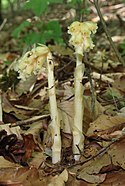
|
NYFA: 4 |
USDA-NN Go Botany VASCAN ARS-GRIN ITIS FNA Tropicos Images Wikispecies |
(Michx.) Raf. 1803. Monotropa lanuginosa Michx.
1810. Hypopitys lanuginosa (Michx.) Raf.
1818. H. lanuginosa (Michx.) Nutt. isonym
1910. Monotropa hypopitys ssp. lanuginosa (Michx.) Purah.
1956. Monotropa hypopitys ssp. lanuginosa (Michx.) H.Hara |
Red pinesap
hairy pine-sap
|
Native, CoC: 8, Unranked |

|
NYFA: Nu |
Go Botany Images Wikispecies |
|
| |||||
Tribe Pterosporeae
[edit | edit source]Pterospora
[edit | edit source]| Genus Pterospora | Pinedrops | N.Y. Status | Images | Distribution | NY NPT |
Nutt. |
Pinedrops, Pine-drops, Woodland pinedrops, Giant pinedrops, Giant birds's-nest, Albany beechdrops |
Native, Endangered |
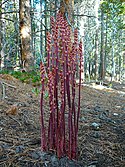
|
NYFA: 1 |
USDA-NN Go Botany Tropicos Images Wikispecies |
|
| |||||
Subfamily Arbutoideae
[edit | edit source]Arctostaphylos
[edit | edit source] bearberry or kinnikinnick |
| Genus Arctostaphylos | Manzanita | N.Y. Status | Images | Distribution | NY NPT |
(L.) Spreng. 1753. Arbutus uva-ursi L. 1812. Arbutus buxifolia Stokes 1813. Mairania uva-ursi (L.) Desv. 1821. Uva-ursi buxifolia (Stokes) Gray 1825. Arctostaphylos uva-ursi (L.) Spreng. 1913. Uva-ursi uva-ursi (L.) Britton taut. |
Red bearberry, Kinnikinnick, Pinemat manzanita, Mealberry, Hog cranberry Raisin d’ours, Arctostaphyle raisin-d'ours, Busserole |
Native, CoC: 8, Secure UPL Perennial, Shrub-subshrub, Sun - shade |

|
Alba Bron Clin Colu Dutc Erie Esse Fran Fult Gene Gree Hami Jeff Lewi Nass Niag Onei Onta Oran Oswe Putn Quee Rens Rich Rock Stla Steu Suff Tomp Ulst Warr Wash NYFA: 5 |
USDA-NN Go Botany VASCAN ARS-GRIN ITIS FNA Tropicos NatureServe BONAP LBJ Images Wikispecies |
|
| |||||
Subfamily Harrimanelloideae
[edit | edit source]Harrimanella
[edit | edit source]| Genus Harrimanella | Harrimanella | N.Y. Status | Images | Distribution | NY NPT |
(L.) Coville |
Moss bell-heather | Native, Likely extirpated |

|
NYFA: Z |
USDA-NN ARS-GRIN Images Wikispecies |
|
| |||||
Subfamily Ericoideae
[edit | edit source]Tribe Phyllodoceae
[edit | edit source]Epigaea
[edit | edit source]| Genus Epigaea | Trailing-arbutus | N.Y. Status | Images | Distribution | 1 NPT |
L. 1753. Epigaea repens L.
1837. Epigaea repens var. rubicunda D.Don
1939. Epigaea repens var. glabrifolia Fernald |
Trailing arbutus ⓘ
Trailing-arbutus ⓘ
Mayflower ⓘ
Creeping mayflower ⓘ
Gravelroot ⓘ
Ground laurel ⓘ Épigée rampante ⓘ
Épigée fleur-de-mai ⓘ
Fleur de mai ⓘ
|
Native, CoC: 7, Likely secure, S4, G5 |

|
NYFA: 4 iNat |
USDA-NN Go Botany VASCAN FNA Tropicos Images Wikispecies |
|
| |||||
Kalmia
[edit | edit source] |
| Genus Kalmia | Laurel | N.Y. Status | Images | Distribution | NY NPT |
L. var. angustifolia |
Sheep-laurel, Sheep-kill |
Native, CoC: 7, Secure |

|
NYFA: 5 |
USDA-NN Go Botany Images Wikispecies |
L. |
Mountain laurel | Native, CoC: 7, Secure |

|
NYFA: 5 |
USDA-N0 Go Botany Images Wikispecies |
Wang. |
Pale laurel, Bog laurel |
Native, CoC: 10, Likely secure |

|
NYFA: 4 |
USDA-NN Go Botany Images Wikispecies |
Loiseleuria procumbens (L.) Desv. |
Alpine azalea | Native, CoC: 10, Endangered |

|
NYFA: 1 |
USDA-NN Go Botany ARS-GRIN ITIS Images Wikispecies |
| Genus Kalmia (excluded taxa) | Laurel | N.Y. Status | Images | Distribution | NY NPT |
(Bergius) Gift & Kron 2008 1777. Ledum buxifolium Bergius 1813. Dendrium buxifolium Desv. 1817. Leiophyllum buxifolium Elliott [1]1839. Leiophyllum lyonii Sweet 1901. Leiophyllum hugeri (Small) K. Schum. |
Sandmyrtle, Sand-myrtle |
N. America native southern U. S., N.Y. excluded |

|
NYFA-Excluded |
USDA-N0 Go Botany ARS-GRIN ITIS FNA Images Wikispecies |
| |||||
Tribe Ericeae
[edit | edit source]Calluna
[edit | edit source]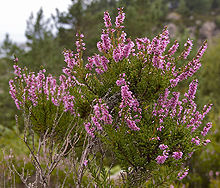 heather |
| Genus Calluna | Heather | N.Y. Status | Images | Distribution | NY NPT |
(L.) Hull 1753. Erica vulgaris L. 1808. Calluna vulgaris (L.) Hull 1906. Ericoides vulgaris (L.) Merino |
Heather, Scotch heather, Scots heather, Common heather, Ling |
Introduced from Eurasia, northern Africa, Naturalized FAC Perennial, Shrub |

|
NYFA: X |
USDA-XX ARS-GRIN Tropicos BONAP Images Wikispecies |
|
| |||||
Tribe Rhodoreae
[edit | edit source]Rhododendron
[edit | edit source]Rhododendron subg. Hymenanthes sect. Pentanthera
[edit | edit source] pinxter flower |
| Genus Rhododendron subg. Hymenanthes sect. Pentanthera | Azalea | N.Y. Status | Images | Distribution | NY NPT |
(Small) Millais 1914. Azalea prinophylla Small
1917. R. prinophyllum (Small) Millais
1921. R. roseum (Loisel.) Rehder superfl.
1924. R. nudiflorum var. roseum (Loisel.) Wiegand |
Early azalea ⓘ
Roseshell azalea ⓘ
Woolly azalea ⓘ
Election-pink ⓘ
|
Native, CoC: 6, Secure FAC Perennial, Shrub, Shade |

|
NYFA: 5 |
USDA-N0 Go Botany VASCAN ARS-GRIN FNA Tropicos BONAP LBJ Images Wikispecies |
(Michx.) Shinners 1762. Azalea nudiflora L. illeg.
1803. A. periclymenoides Michx.
1824. R. nudiflorum (L.) Torr. illeg.
1941. R. nudiflorum f. glandiferum (Porter) Fernald
1962. R. periclymenoides (Michx.) Shinners |
Pinxter flower ⓘ
Pinxter-flower ⓘ
Pinkster
Pink azalea
Election-pink ⓘ
Pinxterbloom azalea ⓘ
|
Native, CoC: 7, Secure FAC Perennial, Shrub |

|
NYFA: 5 |
USDA-N0 Go Botany ARS-GRIN BONAP Images Wikispecies |
(L.) Torr. 1753. Azalea serrulata Small
Azalea viscosa L.
1824. R. viscosum (L.) Torr.
R. serrulatum (Small) Millais |
Swamp azalea
Clammy azalea
|
Native, CoC: 7, Secure |

|
NYFA: 5 |
USDA-N0 Go Botany FNA BONAP Images Wikispecies |
(Michx.) Torrey |
Flame azalea | Introduced from southeastern US, N. America native |

|
NYFA: X |
USDA-N0 Go Botany BONAP Images Wikispecies |
| Genus Rhododendron subg. Hymenanthes sect. Pentanthera (excluded taxa) | Azalea | N.Y. Status | Images | Distribution | NY NPT |
(Pursh) Torr. 1813. Azalea arborescens Pursh
1824. R. arborescens (Pursh) Torr. |
Smooth azalea
Sweet Azalea
|
N. America native, N.Y. excluded |
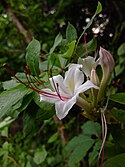
|
NYFA-Excluded |
USDA-N0 Go Botany ARS-GRIN Tropicos BONAP Images Wikispecies Note: 1986[1] |
(Michx.) Sweet 1803. Azalea canescens Michx.
1830. R. canescens (Michx.) Sweet
1900. Azalea nudiflora var. canescens Rehder in L.H.Bailey
1901. Azalea candida Small
1916. R. candidum (Small) Rehder
1921. R. canescens var. candidum (Small) Rehder |
Mountain azalea ⓘ
Hoary azalea ⓘ
Wild azalea
Honeysuckle azalea
Piedmont azalea ⓘ
Sweet azalea
Southern pinxterflower ⓘ
Sweet-Florida pinxter ⓘ
|
N. America native, N.Y. excluded |

|
USDA-N0 Go Botany-0 ARS-GRIN ITIS Tropicos BONAP IPN Images Wikispecies Note: 1918[2] | |
| |||||
Rhododendron subg. Hymenanthes sect. Rhodora
[edit | edit source] rhodora |
| Genus Rhododendron subg. Hymenanthes sect. Rhodora | Rhodora | N.Y. Status | Images | Distribution | NY NPT |
(L.) Torr. 1762. Rhodora canadensis L.
1841. Rhododendron canadense (L.) Torr.
1891. Azalea canadensis (L.) Kuntze |
Rhodora ⓘ
Canada rosebay ⓘ
Canada rhododendron ⓘ
Canadian rhododendron ⓘ Rhododendron du Canada ⓘ
Rhodora ⓘ
Rhodora du Canada ⓘ
|
Native, CoC: 9, Threatened FACW Perennial, Shrub |

|
NYFA: 2 |
USDA-NN Go Botany VASCAN ARS-GRIN Tropicos BONAP Images Wikispecies |
|
| |||||
Rhododendron subg. Hymenanthes sect. Pontica
[edit | edit source]| Genus Rhododendron subg. Hymenanthes sect. Pontica | Rhododendron | N.Y. Status | Images | Distribution | NY NPT |
L. 1753. Rhododendron maximum L.
1935. Rhododendron ashleyi Coker
1943. Hymenanthes maxima (L.) H.F.Copel. |
Great rosebay ⓘ
Great laurel ⓘ
Great rhododendron ⓘ
Rose bay ⓘ
Wild rhododendron
Rosebay rhododendron
|
Native, CoC: 9, Likely secure |

|
NYFA: 4 |
USDA-NN Go Botany ARS-GRIN Tropicos BONAP LBJ Images Wikispecies |
|
| |||||
Rhododendron subg. Rhododendron sect. Rhododendron
[edit | edit source] Lapland rosebay |
| Genus Rhododendron subg. Rhododendron sect. Rhododendron subsect. Ledum | Rhododendron | N.Y. Status | Images | Distribution | NY NPT |
(Oeder) Kron & Judd 1771. Ledum groenlandicum Oeder in G.C.Oeder & al. (eds.), Fl. Dan. 4(10):5 |
Labrador tea, Bog Labrador tea, Common Labrador tea |
Native, CoC: 9, Likely secure |

|
NYFA: 4-5 iNat: |
USDA-NN Go Botany Tropicos BONAP Images Wikispecies |
| Genus Rhododendron subg. Rhododendron sect. Rhododendron subsect. Lapponica | Rhododendron | N.Y. Status | Images | Distribution | NY NPT |
(L.) Wahlenb. Azalea lapponica L. |
Lapland rosebay, Lapland azalea |
Native, CoC: 10, Endangered |

|
NYFA: 1 |
USDA-NN Go Botany BONAP Images Wikispecies |
|
| |||||
Subfamily Empetroideae
[edit | edit source]Empetroideae Sweet, Hort. Brit.: 491. Sep–Oct 1826.
Tribe Empetreae
[edit | edit source]Empetreae Horan., Char. Ess. Fam.: 109. 17 Jun 1847.
Empetrum
[edit | edit source]| Genus Empetrum | Crowberry | N.Y. Status | Images | Distribution | NY NPT |
L. 1753. Empetrum nigrum L. 1913. E. eamesiissp. hermaphroditum 1927. E. hermaphroditum Lange ex Hagerup 1933. E. nigrumvar. hermaphroditum 1952. E. nigrumssp. hermaphroditum |
Black crowberry, Crakeberry, Curlew-berry Camarine noire |
Native, Rare |
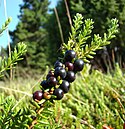
|
NYFA: 3 |
USDA-NN Go Botany VASCAN ARS-GRIN ITIS FNA Images Wikispecies |
Fernald & Wiegand 1913. E. atropurpureum Fernald & Wiegand 1927. E. rubrum var. atropurpureum 1960. E. eamesii ssp. atropurpureum 1966. E. nigrum var. atropurpureum [1] |
Purple crowberry, Red crowberry Camarine noire-pouprée, Camarine atropourpre, Camarine pourpre |
Native, Endangered |

|
NYFA: 1 |
USDA-NN Go Botany VASCAN ITIS FNA Images Wikispecies |
| |||||
Corema
[edit | edit source]| Genus Corema | Crowberry | N.Y. Status | Images | Distribution | NY NPT |
(Torr.) Torr. 1837. Empetrum conradii Torr. 1842. Corema conradii (Torr.) Torr. |
Broom crowberry, Broom-crowberry, Poverty-grass Corème de Conrad, Camarine de Conrad |
Native, Endangered |

|
NYFA: 1 |
USDA-NN Go Botany VASCAN ARS-GRIN ITIS FNA Images Wikispecies |
|
| |||||
Subfamily Vaccinoideae
[edit | edit source]Tribe Oxydendreae
[edit | edit source]Oxydendrum
[edit | edit source]| Genus Oxydendrum | Sourwood | N.Y. Status | Images | Distribution | NY NPT |
(L.) DC. 1753. Andromeda arborea L. 1839. Oxydendrum arboreum (L.) DC. |
Sourwood, Sorreltree, Lily-of-the-valley tree, Swamp-cranberry |
Introduced, US South native |

|
NYFA: X |
USDA-N0 ARS-GRIN ITIS FNA Tropicos NatureServe IPN Images Wikispecies |
|
| |||||
Tribe Lyonieae
[edit | edit source]Lyonia
[edit | edit source] |
| Genus Lyonia | Staggerbush | N.Y. Status | Images | Distribution | NY NPT |
(L.) DC. var. ligustrina 1753. Vaccinium ligustrinum L. 1813. Andromeda ligustrina (L.) Muhl. 1839. Lyonia ligustrina (L.) DC. 1894. Xolisma ligustrina (L.) Britton 1913. Arsenococcus ligustrinus (L.) Small |
Maleberry, Seedy buckberry, Privet andromeda Lyonie faux-troène, Lyonie ligustrine |
Native, Secure |

|
NYFA: 5 |
USDA-N0 Go Botany VASCAN ARS-GRIN ITIS FNA Tropicos NatureServe Images Wikispecies |
(L.) D.Don 1753. Andromeda mariana L. 1834. Lyonia mariana (L.) D.Don 1876. Pieris mariana (L.) Benth. & Hook.f. 1913. Neopieris mariana (L.) Britton 1924. Xolisma mariana (L.) Rehder |
Stagger-bush, Piedmont staggerbush, Maryland staggerbush |
Native, Likely secure |

|
NYFA: 4 |
USDA-N0 Go Botany ARS-GRIN ITIS FNA Tropicos NatureServe IPN Images Wikispecies |
|
| |||||
Tribe Andromedeae
[edit | edit source]Andromeda
[edit | edit source]| Genus Andromeda | Bog-rosemary | N.Y. Status | Images | Distribution | NY NPT |
L. var. latifolia Aiton 1789. A. polifoliavar. latifolia 1821. A. glaucophylla Link 1839. A. polifoliavar. glaucophylla 1914. A. canescens Small 1916. A. glaucophyllavar. iodandra 1924. A. glaucophyllafo. latifolia 1927. A. glaucophyllavar. latifolia 1948. A. polifoliassp. glaucophylla |
Bog rosemary, Glaucous-leaved bog rosemary Andromède glauque |
Native, CoC: 10, Secure OBL Perennial, Shrub |

|
NYFA: 5 |
USDA-NN Go Botany VASCAN ARS-GRIN ITIS FNA Tropicos LBJ Images Wikispecies |
|
| |||||
Tribe Gaultherieae
[edit | edit source]Chamaedaphne
[edit | edit source] leatherleaf |
| Genus Chamaedaphne | Leatherleaf | N.Y. Status | Images | Distribution | NY NPT |
(L.) Moench |
Leatherleaf | Native, CoC: 8, Secure OBL Perennial, Shrub |

|
NYFA: 5 |
USDA-NN Go Botany Images Wikispecies |
|
| |||||
Gaultheria
[edit | edit source] wintergreen |
| Genus Gaultheria | Snowberry | N.Y. Status | Images | Distribution | NY NPT |
L. |
Wintergreen ⓘ
Teaberry ⓘ
Eastern teaberry ⓘ
Checkerberry ⓘ
Eastern spicy-wintergreen ⓘ
Creeping wintergreen ⓘ
Spring wintergreen ⓘ
Mountain-tea ⓘ Thé des bois, Thé rouge, Gaulthérie couchée |
Native, Secure Perennial, Shrub, subshrub |

|
NYFA: 5 |
USDA-NN Go Botany VASCAN ARS-GRIN FNA Tropicos Images Wikispecies |
(L.) Muhl. ex Bigel. Chiogenes hispidula |
Creeping snowberry | Native, Secure |

|
NYFA: 5 |
USDA-NN Go Botany Images Wikispecies |
|
| |||||
Eubotrys
[edit | edit source] |
| Genus Eubotrys | Fetterbush | N.Y. Status | Images | Distribution | NY NPT |
(L.) Nutt. 1842. Eubotrys racemosa (L.) Nutt.
1856. Leucothoe racemosa (L.) A. Gray |
Swamp fetterbush ⓘ
Swamp doghobble ⓘ
Swamp deciduous dog-laurel ⓘ
Deciduous swamp fetterbush ⓘ
Sweetbells ⓘ
Swamp sweetbells ⓘ
|
Native, Likely secure |

|
NYFA: 4 |
USDA-N0 Go Botany FNA Tropicos Images Wikispecies |
(Buckley) Britton |
Mountain fetterbush, Deciduous mountain fetterbush, Redtwig doghobble, Red-twigged doghobble |
Introduced, US South native Perennial, Shrub |

|
NYFA: X |
USDA-N0 BONAP Images Wikispecies |
|
| |||||
Leucothoe
[edit | edit source]| Genus Leucothoe | Doghobble | N.Y. Status | Images | Distribution | NY NPT |
(Steud.) Sleumer |
Highland dog-hobble | Introduced, US South native, Impersistent |

|
NYFA: Xm |
USDA-N0 Go Botany BONAP Images Wikispecies |
(Lam.) D.Don 1783. Andromeda axillaris Lam. 1788. Andromeda catesbaei Walter 1809. Andromeda walteri Willd. 1834. Leucothoe axillaris D.Don 1856. Leucothoe catesbaei A.Gray |
Coastal doghobble | Introduced, US South native, Cultivated, No NY reports Perennial, Shrub |

|
NYFA: 0 |
USDA-N0 ARS-GRIN NatureServe BONAP Images Wikispecies |
|
| |||||
Tribe Vaccinieae
[edit | edit source]| The Vaccinieae contain the morphologically similar huckleberries (Gaylussacia) and blueberries (Vaccinium).
|
Gaylussacia
[edit | edit source]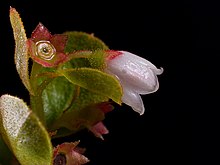 bog huckleberry |
| Genus Gaylussacia | Huckleberry | N.Y. Status | Images | Distribution | NY NPT |
1787. Andromeda baccata Wangenh. 1872. Gaylussacia baccata K.Koch 1900. G. resinosavar. glaucocarpa B.L.Rob. 1907. G. baccatavar. glaucocarpa Mack. 1933. Decachaena baccata Small |
Black huckleberry | Native, Secure |

|
NYFA: 5 |
USDA-NN Go Botany FNA Tropicos Images Wikispecies |
(L.) Torr. & A.Gray 1753. Vaccinium frondosum L. 1843. Gaylussacia frondosa Torr. & A.Gray 1933. Decachaena frondosa ex Small |
Blue huckleberry, Dangleberry |
Native, Likely secure |

|
NYFA: 4 |
USDA-N0 Go Botany ARS-GRIN Images Wikispecies |
(Fernald) Sorrie & Weakley 1911. Gaylussacia dumosa var. bigeloviana Fernald 1933. Lasiococcus dumosusvar. bigelovianus Fernald 2007. Gaylussacia bigeloviana Sorrie & Weakley auct. Gaylussacia dumosa non (Andrews) A.Gray |
Dwarf huckleberry, Bog huckleberry |
Native, Endangered |

|
NYFA: 1-2 |
USDA-NN Go Botany ARS-GRIN ITIS FNA Images Wikispecies |
|
| |||||
Vaccinium
[edit | edit source]| The genus Vaccinium comprises the blueberries, cranberries, huckleberries and similar shrubs. It is here broken down into sections as described in Flora of North America.[1]
|
Vaccinium sect. Cyanococcus
[edit | edit source]| Section Cyanococcus was described by Asa Gray in Memoirs of the American Academy of Arts and Science in 1846.[1] This section contains all of the New York blueberry species except the alpine blueberry.
|
| Genus Vaccinium sect. Cyanococcus | Blueberry | N.Y. Status | Images | Distribution | NY NPT |
Aiton 1789. Vaccinium angustifolium Aiton 1861. V. pensylvanicumvar. nigrum 1894. V. nigrum (Alph.Wood) Britton 1914. V. brittonii Porter ex E. P. Bicknell 1931. Cyanococcus angustifolium (Aiton) Rydb. 1943. V. lamarckii Camp |
Lowbush blueberry, Late lowbush blueberry, Low sweet blueberry, Late sweet blueberry, Sweet-hurts Bleuet à feuilles étroites, Airelle de Pennsylvanie |
Native, CoC: 4, Secure Perennial, Shrub, Sun - shade |

|
NYFA: 5 |
USDA-NN Go Botany VASCAN ARS-GRIN ITIS FNA Tropicos BONAP LBJ Images Wikispecies |
L. 1753. Vaccinium corymbosum L. |
Highbush blueberry, Swamp blueberry, Whortleberry, New Jersey blueberry, Southern blueberry Bleuet en corymbe |
Native, CoC: 6, Secure Perennial, Shrub |

|
NYFA: 5 |
USDA-NN Go Botany VASCAN ARS-GRIN ITIS FNA BONAP Images Wikispecies |
E.P.Bicknell (pro sp.) Vaccinium angustifolium × Vaccinium corymbosum |
Atlantic huckleberry, Hybrid of Lowbush blueberry & Highbush blueberry |
Native, Unranked Perennial, Shrub |

|
NYFA: U |
USDA-N0 ITIS BONAP Images Wikispecies |
Michx. 1803. Vaccinium myrtilloides Michx. 1823. V. canadense Kalm ex Richardson 1917. Cyanococcus canadensis (Kalm ex Richardson) Rydb. 1921. V. angustifoliumvar. myrtilloides |
Velvet-leaved blueberry, Velvet-leaved huckleberry, Velvetleaf huckleberry, Sour-top blueberry, Sourtop, Canada blueberry Bleuet fausse-myrtille, Bleuet rameau-velouté, Bleuet du Canada, Bleuets, Airelle fausse-myrtille, Airelle faux-myrtille, Airelle du Canada |
Native, CoC: 7, Secure Perennial, Shrub |
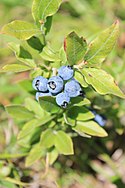
|
NYFA: 5 |
USDA-NN Go Botany VASCAN ARS-GRIN FNA Tropicos BONAP Images Wikispecies |
Aiton 1789. Vaccinium pallidum Aiton 1856. V. corymbosumvar. pallidum 1933. Cyanococcus pallidus (Aiton) Small |
Early lowbush blueberry, Late lowbush blueberry, Blue Ridge blueberry, Hillside blueberry |
Native, CoC: 7, Secure Perennial, Shrub |

|
NYFA: 5 |
USDA-NN Go Botany ARS-GRIN FNA Tropicos BONAP Images Wikispecies |
I.V.Hall & Aalders 1848. V. pensylvanicumvar. angustifolium 1861. V. pensylvanicumvar. alpinum 1961. V. boreale I.V.Hall & Aalders |
Northern blueberry, High-mountain blueberry, Sweet hurts Bleuet boréal |
Native, CoC: 10, Threatened, NYNHP: 2[1] Perennial, Shrub |
NYFA: 2 |
USDA-NN Go Botany VASCAN ARS-GRIN ITIS FNA Tropicos BONAP Images Wikispecies | |
Vaccinium sect. Vaccinium
[edit | edit source]| Genus Vaccinium sect. Vaccinium | Blueberry | N.Y. Status | Images | Distribution | NY NPT |
L. (1753) |
Alpine blueberry, Bog blueberry, Bog bilberry, Bog whortleberry, Northern bilberry, Airelle de marécages |
Native, Rare |

|
NYFA: 3 |
USDA-NN ARS-GRIN ITIS FNA Images Wikispecies |
|
| |||||
Vaccinium sect. Myrtillus
[edit | edit source]| Genus Vaccinium sect. Myrtillus | Dwarf blueberry | N.Y. Status | Images | Distribution | NY NPT |
Michx. 1803. V. caespitosum Michx. 1818. V. geminiflorum Kunth 1899. V. arbuscula (A.Gray) Merriam 1942. V. nivictum Camp 1942. V. paludicola Camp |
Dwarf bilberry, Dwarf blueberry Airelle gazonnante |
Native, Endangered |

|
NYFA: 1 |
USDA-NN Go Botany ARS-GRIN ITIS FNA Tropicos Images Wikispecies |
|
| |||||
Vaccinium sect. Oxycoccus
[edit | edit source]Cranberries (Vaccinium sect. Oxycoccus) can be found in acidic bogs throughout the state.
| Genus Vaccinium sect. Oxycoccus | Cranberry | N.Y. Status | Images | Distribution | NY NPT |
Aiton 1789. Vaccinium macrocarpon Aiton 1803. V. oxycoccosvar. oblongifolium 1805. Oxycoccus macrocarpos (Aiton) Pers. 1805. O. palustrisvar. macrocarpos 1894. Schollera macrocarpos (Aiton) Britton |
Cranberry, Large cranberry, American cranberry Canneberge à gros fruits, Ronce d'Amérique |
Native, CoC: 8, Secure OBL Perennial, Shrub, subshrub |

|
NYFA: 5 |
USDA-NN ARS-GRIN ITIS FNA Tropicos Images Wikispecies |
L. 1753. Vaccinium oxycoccos L. |
Cranberry, Small cranberry, European cranberry Canneberge commune |
Native, CoC: 8, Secure, (circumboreal) OBL Perennial, Shrub, subshrub |

|
NYFA: 5 |
USDA-NN ARS-GRIN ITIS FNA Images Wikispecies |
|
| |||||
Vaccinium sect. Polycodium
[edit | edit source]| Genus Vaccinium sect. Polycodium | Deerberry | N.Y. Status | Images | Distribution | NY NPT |
L. (1753) |
Deerberry, Southern-gooseberry |
Native, Secure |

|
NYFA: 5 |
USDA-NN ARS-GRIN ITIS FNA Images Wikispecies |
|
| |||||






















































